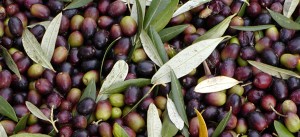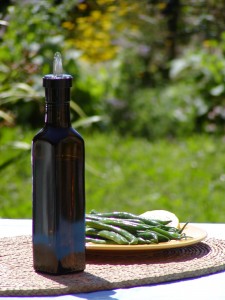When a trained olive oil taste panel replicated a national magazine taste test comparing extra virgin olive oils, the results were very different. This 2007 article explains what happened, and why.
By Alexandra Kicenik Devarenne and Paul Vossen
 When Cook’s Illustrated published an article comparing various extra virgin olive oils, word spread more or less like wildfire through the olive oil tasting community. Most people may not even be aware that there is such a thing, but a small coterie of trained olive oil tasters exists in the United States. An olive oil taste panel located in California was trained by the University of California to international olive oil tasting standards and has been instrumental in the development of a world-class domestic olive oil industry.
When Cook’s Illustrated published an article comparing various extra virgin olive oils, word spread more or less like wildfire through the olive oil tasting community. Most people may not even be aware that there is such a thing, but a small coterie of trained olive oil tasters exists in the United States. An olive oil taste panel located in California was trained by the University of California to international olive oil tasting standards and has been instrumental in the development of a world-class domestic olive oil industry.
The Magazine’s Results
The results of the Cook’s Illustrated tasting (in May 2006) are illuminating. The Italian oils did not fare well: the highest ranking achieved was 5th. The only California oil in the tasting scored 10th. The primary complaint about the Italian oils was that they were too green, pungent and harsh, and that this overwhelmed the olive flavor. The California oil, made from a blend of mostly Tuscan varieties, was cited as especially assertive.
The oils ranked highest by the Cook’s staff were from Spain and Greece. These oils were variously described as having “bold olive flavor,” being “nutty, fruity, good,” “well-rounded” “complex, rich without being bitter,” and being generally olive-fruity and well-balanced. The two top-ranked oils were blends from Spain that prominently featured the Picual variety (probably an important factor in their popularity–more about that later).
Trained olive oil tasters usually read such rankings with a combination of interest, suspicion and disbelief. Taste is taste, after all, and it is a very personal matter. But there is also the question of educating a palate and training yourself to make distinctions that the average person would not notice or appreciate. No one would argue with the assertion that wine tasting is a highly developed skill. And there are many among us who began our wine-drinking careers with stuff that we wouldn’t use to make a marinade today. One can always argue that you like what you like, but you must also admit that there is some consensus among experts about what is a good wine and (especially) what is a defective one.
International Olive Oil Standards and Training
Olive oil is similar to wine in this respect. Yes, people like what they like, but there is also some consensus about what constitutes good oil and bad. The International Olive Council (IOC) standards for the use of the term “extra virgin” are very specific, and only a few of the criteria are assessed with laboratory tests. The most important qualifier for extra virgin classification is the absence of sensory defects and the presence of some olive fruitiness. In plain English, this means that the oil cannot be rancid, or taste of rotten fruit, dirty equipment, fermenting paste, wastewater, or anything other than fresh olives. The olives can be green or ripe, or any mixture thereof, and they can be of any combination of over a thousand varieties (each having its own distinctive characteristics).
It should be noted at this point that the IOC standards for “extra virgin” qualification are not enforced in this country. The label on an olive oil bottle can make claims to “extra virgin” status without ever having to prove the fact. The only enforcement is of the term “olive oil;” the oil must come from olives only and not be adulterated with other oils. This lack of oversight has led to tremendous consumer uncertainty in the olive oil section of the market.
Learning to detect and identify the classic defects of olive oil is one of the first and most critical parts of a taster’s training; panels that certify oils as “extra virgin” are concerned primarily with weeding out defective oils. One of the most common defects (rancidity) will occur in any oil given enough time, but can be present from the start if the oil was contaminated during processing or storage. Most defects result from poor fruit handling or processing problems prior to bottling. Olives fermenting in the absence of oxygen acquire a distinctive and common defect referred to as “fusty.” This fermentation takes place when olives are allowed to sit for extended periods before milling. This is a common practice since speedy harvest, transport and processing are demanding and more costly for the producer. There are other classic defects, and also a wide range of non-specific “off” flavors.
Evaluating the positive aspects of olive oil is also part of the training, and quantifying the primary positive attributes is part of any certification tasting. The three primary positives are fruitiness, pungency and bitterness. Yes, pungency and bitterness. It is probably a little tough for most Americans to adjust to, but bitterness and pungency are regarded as positive characteristics of olive oil. Olives naturally contain various compounds that taste bitter or pungent, and these compounds are the antioxidants and other phytochemicals that make olive oil so good for you. Americans don’t usually regard bitterness too highly; think “bitter pill,” “bitter cold,” or even “bitter old person.” This disdain is not universal. Bitter flavors are part of many cuisines: think of the taste of Campari for example, or of bitter salad greens. And pungency (aka peppery or picante) is also prized by many cultures. Both are acquired tastes, however, and not very novice-friendly.
A Matter of Style
It should be noted that olive oil doesn’t have to be bitter and pungent to qualify as extra virgin, and many olive oils are not. Bitterness and pungency decline as olives ripen, and oil made from ripe olives can have little or none of those qualities. Ripe oils are also less stable, since bitterness and pungency indicate the presence of antioxidants that preserve freshness. The shelf life of a properly stored high-polyphenol olive oil is a least two years; a ripe, low-polyphenol oil can become rancid in half that time. Degree of ripeness is a question of style, really, and regional or personal preference. In this regard, Italian olive oils tend to be painted rather broadly with a Tuscan brush; many Italian oils are ripe and fruity and not at all like the “green monster” (as they are called in the Cook’s article) oils from Tuscany. And it is important to remember that there is a difference between olive oil tasted straight out of a glass and olive oil used on food. The bitterness and pungency of an oil are much less prominent when the oil is paired with the right food.
And what do the “experts” look for? When judging for competition or when doing an assessment of the overall quality of an olive oil, the two big items for most tasters—this is assuming that we are looking at an oil with no defects—are probably harmony and complexity. By “harmony,” tasters mean the balance of flavors including bitterness, pungency and fruitiness; “complexity” refers to the variety of different flavors present in the fruit, including both green and ripe characteristics. The top-rated oils tend to be the ones that have pleasing proportions of bitterness and pungency to fruitiness (the fruitiness always being the strongest of the three) and a wide range of ripe and green flavors in the fruit. It might be argued that trained tasters, with their fondness for bitterness, pungency and complex fruit flavors, are not representative of the average consumer. That is probably true. But how many Americans first start drinking wine with Cabernet Sauvignon?
Tasting Results
Seven months after the original Cook’s tasting, the University of California research taste panel blind-tasted the same oils as the Cook’s staff, in the same way. The panel was asked to rank them in order of preference based on both plain tasting and how the oils fared with bread and fresh mozzarella cheese. The Cook’s staff had ranked the oils in order of preference as follows:
1. Picual/Hojiblanca blend, about $29/liter (Spain)
2. Picual/Hojiblanca/Picudo blend, about $56/liter (Spain)
3. Koroneiki, about $20/liter (Greece)
4. Arbequina, about $29/liter (Spain)
5. Nocellara del Bellice, $21/liter (Italy)
6. Frantoio, Leccino, Pendolino, Moraiolo blend, $29.58/liter (Italy)
7. Blend, including Moraiolo, $22.98/liter (Italy)
8. Frantoio, Leccino, Pendolino, Moraiolo (Italy)
9. Arbequina, $42/liter (Spain)
10. Frantoio, Leccino, Pendolino, Maurino, Coratina, Leccio del Corno blend (California)
11. Unstated varieties $12.99/liter (Various countries)
The results from the taste panel were very different. Four of the oils rated highest in the magazine tasting were found to be defective by the trained tasters. The most common defect was rancidity, followed by fustiness (the flavor of anaerobic fermentation). The oil ranked 5th by the magazine staff was the top choice of the taste panel. “Fresh, crisp, clean,” “strong varietal character,” “good, rich, intense flavor,” “balanced” and “complex” were some of the comments. The oil got some strong positives from the magazine staff as well, but was down-rated for a “slightly bitter” profile that was “too much” for some. The number 10 oil from the magazine line-up was ranked number 2 by the taste panel, who called it “balanced,” with “mellow bitterness and pungency just right,” also “light,” “floral, sweet.” It was considered the most food-friendly of the oils by most of the tasters.
In general, the Italian oils fared very well in the taste panel rankings, as did the California oil; the Greek and Spanish oils did not do so well. This was a blind tasting for both groups, so national chauvinism couldn’t have been a factor. Why the discrepancy between the two groups? The answer probably lies in style and familiarity. Oils from Spain (and Greece) are usually made from olives harvested later and therefore have lower levels of the polyphenol compounds that cause pungency and bitterness.
Familiarity and Preferences
Familiarity is also a critical factor; we like what we know. This issue looms large in olive oil preferences, because what we know (and therefore what we like) may not be good characteristics for an olive oil. One of the ironies of having a long-standing tradition of olive oil in your country is that it may have led to everyone developing a taste for defective olive oil. In days of yore, when a farmer had to rely on his family for harvest labor and on his donkey for transport to the communal mill, virtually all the olive oil was fusty because the olives sat around for days or even weeks before being processed. That was simply what olive oil tasted like, and everyone liked it. In a sense this has happened in the US as well. American consumers are most likely to purchase their oils in a supermarket from a large import company. Most of the oil in those containers is from the number one producer of olive oil in the world—Spain—and was made from the number one olive: Picual.
The Picual Controversy
This brings up one of the great debates of the olive oil world, the infamous Picual controversy. Picual oil tastes and smells fusty to trained olive oil tasters, or more specifically, like classic over-ripe, fusty Picual. For anyone used to American supermarket oil, the flavor of classic Picual is very familiar. This variety accounts for 80% of the six million acres of olives in Spain. It is a popular olive for good reason: it is very hardy, easy to pick, high in easily extracted oil and prolific. Why the bad rap? In a sense, Picual is a victim of its own popularity. Because there is so much of it planted, only a small fraction of it is harvested at its prime. Traditionally, Picual is picked slowly and steadily until it is all harvested. This can take months. And the same quality that makes it easy to harvest also makes it prone to falling off the trees if disturbed. Rotten olives are not left on the ground, they are picked up and tossed in with the rest of the fruit. The result of this is an oil with a very distinctive flavor described kindly as “eucalyptus.” It is actually a combination of the defect “fusty” and the inherent over-ripe varietal character of the olive.
In Spain this is a familiar flavor and it is embraced as the flavor of Picual. In Italy, it is equally familiar, and scorned as the flavor of Picual (but Italians still buy lots of it and use it to make refined olive oil or to sell to Americans). The true flavor of Picual is actually fantastic; harvested at the right time and treated well, it produces a glorious, rich, fruity olive oil with a great balance of bitterness and pungency. There is no trace of the curse of the overripe Picual. But since that “classic Picual” flavor so familiar to the Spanish, they don’t necessarily regard it as a defect. There are Spanish producers who have gotten wise about this and now produce superb Picual oils, but boatloads of “traditional” Picual are still produced as well. Because so much of the olive oil on American supermarket shelves is either this Picual or something else fusty, most Americans are accustomed to fustiness. One of the attendees at a sensory evaluation course (who had an extraordinarily acute sense of smell) embodied it perfectly when she smelled the defect “fusty” and confided that she thought that was just the smell of olive oil.
Starting Mild, But Fresh
The world of premium extra virgin olive oil is a fascinating one, and well worth exploring. Americans probably need to be introduced first to a mild olive oil from a variety with low inherent bitterness that was harvested fairly mature but then processed with immaculate care and attention to detail (a California Arbequina, for example). That might serve as an introduction to a more sophisticated appreciation of the qualities of excellent olive oil (the equivalent of the soft fruity Merlot for a wine education, to continue that analogy). There are so many wonderful olive oils in the world, and learning to appreciate them is a delightful (and healthy) pastime.
*Previously published in First Press: Newsletter of Olive Oil Production and Evaluation © UC Regents


Trackbacks/Pingbacks